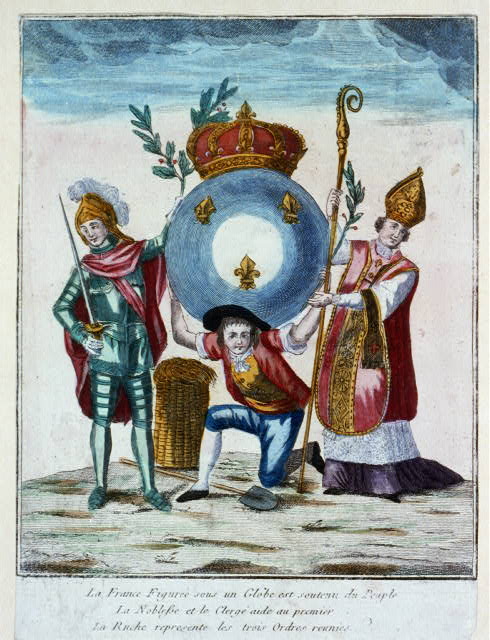Summary of the Three Estates
Prior to the French Revolution of 1789, the population of France was categorized into three estates. The First Estate consisted of members of the Catholic Church (the clergy). The Second Estate consisted of members of the aristocracy (the nobility). The Third Estate comprised all other members of french society (the commoners). The vast majority of the population belonged to the Third Estate (roughly 98% of 27 million people). Despite its size, the Third Estate was largely excluded from political power until the creation of the National Assembly in June 1789. In the Ancien Régime, the First and Second Estates were often referred to as the ‘Privileged Orders’ because these estates controlled disproportionate amounts of power and wealth.

The First Estate
The First Estate was composed of the clergy and modern historians estimate it numbered between 100,000 and 160,000 individuals (roughly 0.5% of the total population).
Despite its small size, the First Estate wielded considerable political and social power as it conferred legitimacy on the King’s ‘Divine Right’ to rule. Furthermore, the First Estate owned large amounts of French property and enjoyed numerous privileges. Roughly 10% of French land was owned by the church and the First Estate was exempt from many forms of taxation.
Although consisting exclusively of members of the Catholic Church, the First Estate experienced notable divisions. Parish priests (who were originally commoners from the Third Estate) and members of the higher clergy (who were generally aristocrats). While not unbridgeable, these divisions were considerable and played a key role in the creation of the National Assembly during the deadlock of the Estate General’s verification in May and June 1789.
The Second Estate
The Second Estate was composed of members of the aristocracy and historians debate its size. Some scholars have suggested the group numbered between 350,000 – 400,000, while others have proposed it could be half that (totally roughly 1-1.5% of the total population).
Like the First Estate, the Second Estate owned a significant amount of property (roughly 20% of French land) and was exempt from many forms of taxation (it is not true that the nobility escaped all forms of taxation). Additionally, aristocrats enjoyed exclusive access to many government, religious, and military positions. Ambassadors, ministers, military commanders, and members of the higher clergy (such as bishops and archbishops) were almost always members of the aristocracy. Finally, many members of the nobility claimed a range of seigneurial dues (feudal dues) which benefited the holder in a variety of ways. These feudal rights might require labor or taxes from local peasants, or confer monopolies of some kind to the holder.
The Second Estate was not homogenous and considerable division existed within the order. Religion, politics, wealth, and history drove deep divisions within the Second Estate, ensuring a highly fractured order incapable of uniting as one against the revolution. While the counter-revolution was led by aristocrats, many of the revolution’s original leading men were also members of the nobility (including the Marquis de Lafayette, the Comte de Mirabeau, and Talleyrand).
The Third Estate
The Third Estate was composed of all commoners and was highly non-homogeneous in nature. This estate included wealthy merchants, educated bourgeoisie, skilled artisans, and illiterate peasants. As a proportion of the population, roughly 98% of France belonged to the Third Estate, justifying Abbe Sieyes’ description as the Third Estate being “everything”.
Collectively, the Third Estate owned a disproportionately small amount of french land compared to the two privileged orders (roughly 70%). However, taxation inequality was even more severe. Members of the Third Estate were required to pay a range of direct and indirect taxes, as well as seigneurial dues, many of which were not paid by members of the privileged orders. With the French Revolution originating from a fiscal crisis, taxation reform was a critical and sensitive issue in the immediate years prior to the revolution of 1789.

Despite its size and taxation burden, the Third Estate was actively excluded from power. Many offices and posts were the exclusive domain of the nobility, denying members of the Third Estate avenues to participate in both politics and government. Taxed more than the privileged orders, yet denied many of the privileges and rights they enjoyed, the Third Estate resented the Old Regime and desired significant reform.